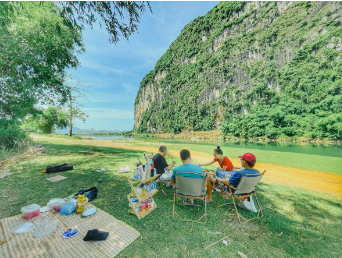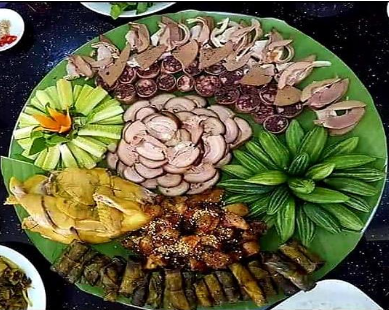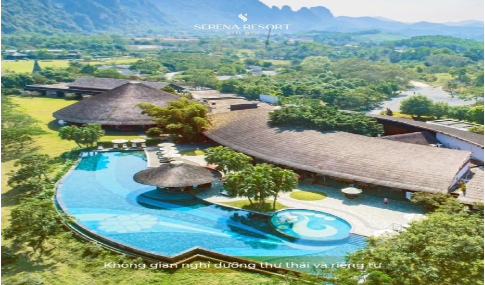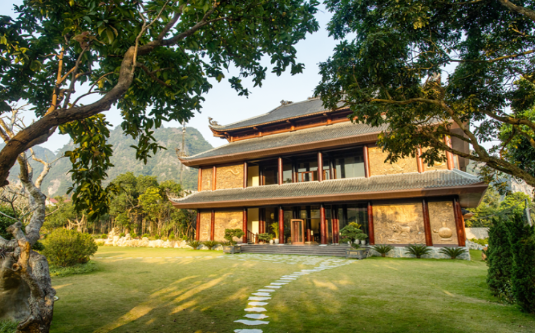X

An entrance to Xom Trai cave, the home of prehistoric Hoa Binh.
Life of primitive people in Hoa Binh
Hoa Binh culture is dated 15,000 years ago, extending to 2,000 years BC, stretching across the land alternating limestone mountains in the west of the Delta 3 large rivers in the North and with large and typical space. for both Southeast Asia and South China. This culture of Hoa Binh was officially announced by archaeologists in 1932, as proposed by Madeleine Colani, after being approved by the Vien Dong Prehistoric Congress in Hanoi.
The Hoa Binh Cultural Phrase is used to refer to the pebble culture that is chiseled throughout the perimeter of the cobblestone to create tools from old stone to new stone. This is a distinguishing feature to the stone inhabitants who use flint, which is easy to make and easier to make.
Particularly in the land of Hoa Binh is one of the places where archaeologists prove that ancient Vietnamese people lived thousands of years ago. There were 47 ancient bronze drums found, including the Da river bronze drum and the Mieu Mon bronze drum, beautiful and ancient.
Besides, there is a system of relics such as Muoi cave - a place of primitive residence for a long time. People also identified many stone tools, kitchen relics, and bones of primitive people. Or as in Khoài cave monument- Vietnam dating pebble industry, the residence of primitive people 17,000 years ago to 11,000 years ago.
Or at the ancient tomb of Dong Thech- Where there are hundreds of tombs around buried many graves, with graves as high as 3m, engraved Chinese names of dead people. Muong people in Hoa Binh believe that the dead still have souls that reside and put them into stone.
Remarkably, in Hang Chua monument, there is also the name "Van Quan Dong" carved on the cliffs, under the inscription of poetry and the 18-19th century writing. Especially the latest discovery about ancient pathways 22,000 years ago at Xom Trai cave, Tan Lap commune, Muong Vang, Lac Son (Hoa Binh) has affirmed that. Xom Trai Cave has an average door width of 7m, a length of 22m, a depth of 7-10m over thousands of years of burial, mainly solid ken shells, showing that it must be accumulated for thousands of years. so.

Build fire and living scenes of people in Hoa Binh culture
Some archaeologists consider this cave to be a permanent residence of primitive people in Hoa Binh culture. It is found that the ancient passage discovered in the northern corner of the cave dates back to 22,000 years, the first passage of the primitive man to enter the cave. This place is both a tool factory of Hoa Binh cultural residents. So far more than 4,000 artifacts have been excavated here.
Especially in addition to the ancient aisle, archaeologists also discovered the ash ashes and the remains of the aged over 14,000 years to 17,000 years. Earlier in the excavation in the 80s of the last century, researchers also found the grain of ancient people spilled, determined during the Tran dynasty.
The researchers also found grave remains at the end of the Tran dynasty in the early Le period, almost intact. Primitive people in Hoa Binh culture have known to insert stone stones, spreading rubble around graves to protect.
Through the remains found in burial sites, according to archaeologists, it is possible to imagine prehistoric Hoa Binh people having the following characteristics: large, healthy stature; skulls are long and tall; face is wide, medium eye socket, wide nasal cavity; low tooth wear; There are people up to 70 years old. Hoa Binh residents have burial forms with many different customs.
For the ancient Peaceful people, the dead do not mean all but just transfer from one world to another. Therefore, in tombs, we meet burial items such as stone tools, jewelry with pearl shells, snail shells or animal bones.
Also at Xom Trai cave, archaeologists also found stone axes, animal bones, rice husks, walnut shells and many fossils of snail shells. This is considered a common food of the ancient Vietnamese. The way of snail food of the ancient Vietnamese is inherited to this day. Muong people in Hoa Binh still eat snails by chopping their tails to suck meat.
Techniques for developing development tools
As mentioned above, Hoa Binh culture has a high level of stone making. For example, in the ruins of Xom Trai cave, it is found that the tool of sharpening stone blades is quite rich, it shows the skillful stone manipulation technique of the ancient Vietnamese.
For example, at Con Moong cave relic in Thanh Yen commune (Thach Ban district, Thanh Hoa). This is a large cave, the cave floor is 40m higher than the foot of the mountain and 300m2 wider. Primitive people were allowed to reside here continuously from Son Vi Culture to Hoa Binh and Bac Son. Evidence is here that archaeologists found many mollusks, plant humus.
Hoa Binh cultural residents residing here are said to have crafted pebble tools but the technique is very developed, the tools are oval or almond shaped, the cobblestone is crafted with the pruning tricks more sharp, more diverse functions such as cutting, cutting, scraping ...
Among the tools, short axes account for a large number, the function of the short ax is also very diverse, can be used as a stone pickaxe. The stripped piece is not much, but most of it has been machined to create a scraping tool, stone knife. Residents of Con Moong also have quite high techniques of making tools from animal bones, which is that they only choose mammal bones to manipulate, this type of bone has many fibers so it is stronger and stronger.

Production tool of Hoa Binh Culture residents in the new stone period
Another place to recognize the ancient Vietnamese remains. Stone roofs also contain many cultural layers of different Stone Age, this date of relics is about 8,200 years. Cultural floor in stone roof Article about 4m thick, proving long-term residence of people. Archaeologists have obtained here many stone tools characterized Hoa Binh culture, especially short axes, pestle crushers, grinding tables, stone tools that have appeared stone grinding techniques.
Techniques for developing development tools of ancient Vietnamese in Hoa Binh culture have also been proved too discovered at Lac Thuy relic. For a long time this is one of the places of human settlement. Many artifacts like bronze drums were found here in the metal age, 4,000 years ago.
Archaeologists also found in Lac Thuy many stone tools, carvings on the cliffs - the prehistoric Hoa Binh had no writing but they had a series of symbols and drawings on the stone to record memories , depicting reality, the world around ...
From the discovered relics, archaeologists prove that prehistoric Hoa Binh people did not confine themselves in the deep mountains but began to move along the valleys of rivers and streams, towards the low plains, artifacts such as sea shells in the cave, graves have partly said this. It is one of the characteristics of the monument of Hoa Binh culture.
From the artifacts found, the ancient Vietnamese people living here had snatched snails and snails to eat and discarded the shells to form thick sediments in the caves. In addition, people also found crushed pestle, stripped by turtle shell and some other tools. It proves that Lac Thuy culture has inherited the Son Vi cultural heritage.
In particular, archaeologists also found the initial traces of the early agriculture of the primitive people living in Lac Thuy such as the Roof Stone Cave (Phu Lao commune), and the Card Bac Cave (Khoan Du commune). In the economic activity of Hoa Binh residents, although hunting and gathering do not hold a unique position, it is still a major economic industry and a new crop arises.
In some relics such as Xom Trai Cave, there were traces of burnt grains, rice husks, and burnt rice seeds. This shows that today, more than ten thousand years ago, Hoa Binh residents are one of the first residents to develop agriculture and Vietnam, in particular, Hoa Binh is one of the centers of agricultural inventions. the earliest in the world.














_636886053534704917.jpg)




